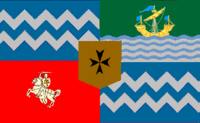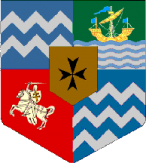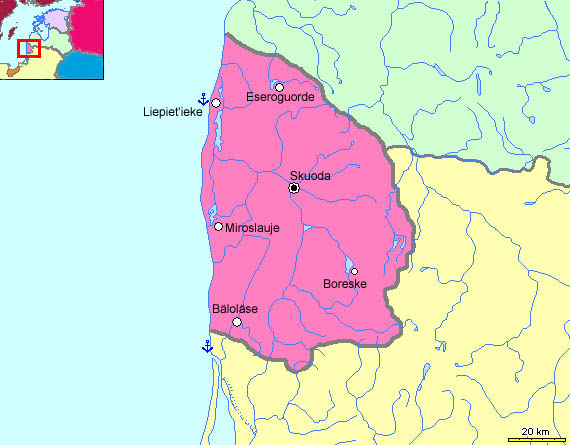Skuodia
| Conventional short name: | |
| Local: | Skuodija |
| English: | Skuodia |

| |
| Languages: | |
| Official: | Skuodian |
| Others: | Lithuanian, Latvian, Yiddish, Wenedyk |
| Cities: | |
| Capital: | Skuoda (76 000) |
| Other: | Liepiet’ieke (34 000), Bäloläse (19 000) |
| Head of State: | Prince Timotieje II |
| Prime Minister: | Georgij Niesedanuove |
| Independence: | from Latvia and Lithuania |
| Date: | 1949 |
| Organizations: | Baltic League |
Administration
Government
- Head of State: Prince Timotieje II
- Prime Minister: Georgij Niesedanuove
History
Skuodia started to emerge in about the 4th or 5th century AD, when a group of Pomorian Slavs migrated across the Baltic Sea to approximately what is now Skuodia and the adjacent regions of Latvia. The exact dates of this settlement are unclear, but at least Iordanes mentions certain skodae in connection with the Goths' 2nd century resettlement southwards. Incidentally, this skodae is glossed (in Gothic!) as so skaudisko þiuda.
Be that as it may, in the early 6th century we have a German manuscript, now kept in the Bodleian Library, University of Oxford, mentioning regio skudorum trans mari Germanico, whence a certain St. Brendan came to Trier. Apparently Skuodia had some contacts with the rest of Christian Europe, but it was less touched by the turmoil of the time. Skuodian culture of that period is typically compared with Ireland, as it is a peripheral region which has both preserved the Christian heritage and absorbed local culture. The rich literary tradition of Old Skuodian is one of the principal sources for comparative Indo-European and Finno-Ugric mythological studies; however it also provides some invaluable information on early medieval Christian culture.
The principal collection of Old Skuodian documents is situated in the archives of the Archbishopric of Skuoda where the chronicles have been kept in a line unbroken from 923 AD. In 1772, under an order from Empress Catherine II of Russia, most of the archive was transferred to St. Petersburg to the imperial archives and the documents have been kept at the Hermitage for the past two centuries. In 1993, as an act of goodwill, the government of the Russian Federation agreed to surrender those priceless manuscripts to where they belong. They are now on display at the Skuodian National Museum of History in Krieloske near Skuoda. These archives include several 10th-century records of the Skuodian learned oral tradition, for example, the Sluovo Guolodoboreskuo (‘The Tale of Vladobor’), often seen as Skuodia’s national epic.
The Skuodian realm appears to have encompassed, for a long time, two sides of the Baltic. Pomorian Skuodia was, however, finally crushed by the Germanic onslaught. It can also be hypothesized that the languages of the two parts of the principality would drift apart, since that of modern Skuodia would come under extremely strong influence from the Finnic and Baltic tribes over whom the invading Slavs ruled. As a result, Skuodian took its peculiar shape.
The Principality of Skuodia encompassed large territories on the eastern shore of the Baltic, striving to control the Finnic and Baltic majority there. Especially prominent in this respect were the Curs, a Baltic tribe who ravaged the coasts of the Baltic. After the Battle of Bäloläse (1074), where the Skuodians were victorious, Skuodian domination was finally established.
Skuodian was elevated to a high status then, and most of the extant Old Skuodian texts are known from manuscripts of this period. The princely court at Skuoda was an important cultural centre. Famous figures of that time include Danile Konisenike, Aliesandare Guornike and Jovane Pierbiegune, abbot of the Monastery of St. Theophilus.
The splendour of Skuodia came to an end after the wars with the Teutonic and Livonian Orders and subsequently the rise of Lithuania, who controlled Baltic trade through the Daugava and the port of Riga. In 1437, the Skuodians were defeated by the joint forces of Lithuania and Pskov. By the Treaty of Kaunas, signed the following year, Prince Aliesiej surrendered his sceptre to the Grand Duke of Lithuania. Skuodian quickly lost its status as an official language and came under strong influence from Lithuanian and subsequently Wenedyk. This twilight period is known as Middle Skuodian. The monasteries, however, kept the written tradition flickering, and the towns of Skuoda and Liepiet’eke (the latter a Hansa member) made sure the language did not die out completely. The area, however, was diminished, especially in the more northerly regions.

|
| Skuodia's Coat of Arms |
After the partitions of the RTC, Skuodian territory became divided into two halves: the north went to Russia, and the south remained with Lithuania. This became, in part, a trigger for the national revival, which hit Skuodia almost as hard as any other nation in Europe. The Russian authorities did not permit much publishing (and talking) in Skuodian, as they had learned to be wary of national revivals, thinking them dangerous and prone to turn into revolutionary movements. On the southern side of the border, however, things went a little better. This period produced such brilliant writers as Markus Jovanuove, Teodore Senivekuove and Aliesandare Potikine, the creators of the modern literary language.
The fortunes were reversed after GW1, as northern Skuodia became part of Latvia and the southern fell under the dominance of independent Lithuania, where minorities were suppressed. The plight of the Skuodians, like that of the Belarusians, was picked up by the SNOR, and after GWII Skuodian independence was reinstitutionalized as the Slavic Republic of Skuodia. It was not until after the collapse of the SNOR that Skuodia gained true independence.
Now the Principality of Skuodia (Koniengestvo Skuodija) is a constitutional monarchy. The current Prince (konienge) is Timotieje II. His lineage goes right back to the ancient Skuodian princes, and these were, according to legend, called from Denmark. Prince Timotieje can claim lineage from Scef mentioned in Beowulf.
Skuodia is a lively and vibrant culture. Situated on the ancient crossroads of Eastern Europe, in the Baltic, Skuodia has enjoyed more than 1,500 years of tolerance, dialogue and exchange. As a member of the Baltic League, Skuodia plays a part in all the developments in the region, and has been termed ‘The Jervaine of Eastern Europe’.
Geography
Skuodia is delimited by Latvia (in the north), by Lithuania (RTC) in the south, and by the Baltic Sea in the west.
Map
Culture
Languages
Languages: Skuodian, Lithuanian, Latvian, Yiddish, Wenedyk
Religion
Religions: Roman Catholicism (82%), Romuva (4%), Judaism (5%), Lutheran(3%), Eastern Orthodox (2%)
